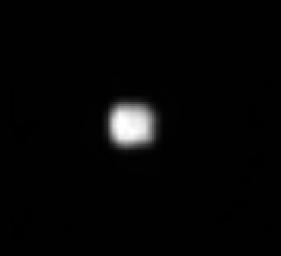
|
Helene from Afar
- Click the image above for a larger view
- Full-Res JPEG (135 x 123) (0.7 kB)
- Full-Res TIFF (135 x 123) (16.9 kB)
Caption:
Saturn's moons Helene and tiny Polydeuces (not seen here) are Trojan moons of Dione, orbiting about 60 degrees ahead of and behind, the much larger moon. Trojan moons are found near gravitationally stable points ahead or behind a larger moon. Polydeuces (or S/2004 S5) was discovered by the Cassini imaging team. Helene is 32 kilometers (20 miles) across, while Dione is 1,118 kilometers (695 miles) across.
Tethys also has two of its own Trojan moons.
The image was taken in visible light with the Cassini spacecraft narrow-angle camera on May 20, 2005, at a distance of approximately 760,000 kilometers (472,000 miles) from Helene. The image scale is 5 kilometers (3 miles) per pixel. This view of Helene has been magnified by a factor of three and sharpened to aid visibility.
Background Info:
The Cassini-Huygens mission is a cooperative project of NASA, the European Space Agency and the Italian Space Agency. The Jet Propulsion Laboratory, a division of the California Institute of Technology in Pasadena, manages the mission for NASA's Science Mission Directorate, Washington, D.C. The Cassini orbiter and its two onboard cameras were designed, developed and assembled at JPL. The imaging team is based at the Space Science Institute, Boulder, Colo.
For more information about the Cassini-Huygens mission visit http://saturn.jpl.nasa.gov . For additional images visit the Cassini imaging team homepage http://ciclops.org .
Cataloging Keywords:
| Name | Value | Additional Values |
|---|---|---|
| Target | Dione | Helene, Polydeuces, Tethys |
| System | Saturn | |
| Target Type | Satellite | |
| Mission | Cassini-Huygens | |
| Instrument Host | Cassini Orbiter | |
| Host Type | Orbiter | |
| Instrument | Imaging Science Subsystem (ISS) | |
| Detector | Narrow Angle Camera | |
| Extra Keywords | Grayscale, Visual | |
| Acquisition Date | ||
| Release Date | 2005-07-21 | |
| Date in Caption | 2005-05-20 | |
| Image Credit | NASA/JPL/Space Science Institute | |
| Source | photojournal.jpl.nasa.gov/catalog/PIA07547 | |
| Identifier | PIA07547 | |
